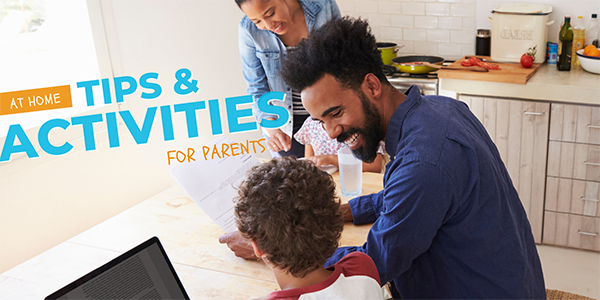Parents, are you struggling to find the balance between work, school and time with your children? We’ve gathered some tips from the CDC to help your family stay healthy and continue learning during this time.
We also want to help keep your children entertained while you're completing your schoolwork. Click here to download a Cody Coyote coloring page. Check back as we add more activities for you and your children.
 |
| Click here to download the full-size coloring page. |
Keep children healthy
Watch your child for any signs of illness
- If you see any sign of illness consistent with symptoms of COVID-19, particularly fever, cough, or shortness of breath, call your healthcare provider and keep your child at home and away from others as much as possible. Follow CDC’s guidance on what to do if you are sick.
Watch for signs of stress in your child
- Some common changes to watch for include excessive worry or sadness, unhealthy eating or sleeping habits, and difficulty with attention and concentration. For more information, see the “For Parents” section of CDC’s Stress and Coping.
- Take time to talk with your child or teen about the COVID-19 outbreak. Answer questions and share facts about COVID-19 in a way that your child or teen can understand.
- Go to CDC’s Helping Children Cope with Emergencies or Talking with Children About COVID-19 for more information.
Teach and reinforce everyday preventive actions
- Parents and caretakers play an important role in teaching children to wash their hands. Explain that handwashing can keep them healthy and stop the virus from spreading to others.
- Be a good role model—if you wash your hands often, they’re more likely to do the same.
- Make handwashing a family activity.
- Learn more about handwashing and other everyday preventive actions.
Help your child stay active
- Encourage your child to play outdoors—it’s great for physical and mental health. Take a walk with your child or go on a bike ride.
- Use indoor activity breaks (like stretch breaks or dance breaks) throughout the day to help your child stay healthy and focused.
Help your child stay socially connected
- Reach out to friends and family via phone or video chats.
- Write cards or letters to family members they may not be able to visit.
- Some schools and non-profits, such as the Collaborative for Academic, Social, and Emotional Learning and The Yale Center for Emotional Intelligence, have resources for social and emotional learning. Check to see if your school has tips and guidelines to help support social and emotional needs of your child.
Ask about school meal services
- Check with your school on plans to continue meal services during the school dismissal. Many schools are keeping school facilities open to allow families to pick up meals or are providing grab-and-go meals at a central location.
- Read our East Valley Community Resources blog for a list of school districts offering free meal pickups.
Help children continue learning
Stay in touch with your child’s school
- Many schools are offering lessons online (virtual learning). Review assignments from the school, and help your child establish a reasonable pace for completing the work. You may need to assist your child with turning on devices, reading instructions, and typing answers.
- Communicate challenges to your school. If you face technology or connectivity issues, or if your child is having a hard time completing assignments, let the school know.
Create a flexible schedule and routine for learning at home
- Have consistent bedtimes and get up at the same time, Monday through Friday.
- Structure the day for learning, free time, healthy meals and snacks, and physical activity.
- Allow flexibility in the schedule—it’s okay to adapt based on your day.
Consider the needs and adjustment required for your child’s age group
- The transition to being at home will be different for preschoolers, K-5, middle school students, and high school students. Talk to your child about expectations and how they are adjusting to being at home versus at school.
- Consider ways your child can stay connected with their friends without spending time in person.
Look for ways to make learning fun
- Have hands-on activities, like puzzles, painting, drawing, and making things.
- Independent play can also be used in place of structured learning. Encourage children to build a fort from sheets or practice counting by stacking blocks.
- Practice handwriting and grammar by writing letters to family members. This is a great way to connect and limit face-to-face contact.
- Start a journal with your child to document this time and discuss the shared experience.
- Use audiobooks or see if your local library is hosting virtual or live-streamed reading events.
Additional Resources
- 18 Tips On How To Cope With Children During Quarantine via Forbes
- How to Master Working From Home—While Under Quarantine With Kids via Parents
- How to home-school during coronavirus quarantine: Moms, teachers share ideas, advice via USA Today
- Parenting During a Pandemic via The Atlantic
- Homeschooling Tips From Actual Teachers via The Cut


No comments:
Post a Comment
Note: Only a member of this blog may post a comment.